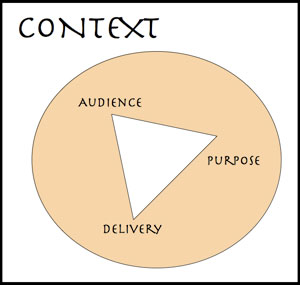
So let’s define distribution. Based on my interpretation and application, I view it as the vehicle by which we touch our audience with our message. It is a channel through which the audience receives and interprets the message for consumption. So if we look at online video, it can be a primary or even a secondary distribution mechanism for our message(s).
Think for a second, before online video…video was television. Our message was created and distributed via television stations and their trafficking of advertising campaigns. We would also use video to reach our audiences via trade show presentations, internal communication avenues, or where ever their was a television. The broadcast tube was the distribution mechanism and it was primary.
As the ability to distribute video over the internet grew, the screen on a computer was not the only way to distribute this visual message. Video messages have to rest on some URL, some individual domain for us to find and watch the information. But this is only a small portion of the distribution for video. With television, you could put it on a VHS tape, DVD, or pay for advertising space. The vehicle here for distribution was merely finding the right channel.
With online video…the primary points of distribution became “infinite” with huge different channels of URL’s…making it hard for audiences to find this content. This is how the social media space began to explode…beginning with email. Email to me is a social media outlet. It is social and just as asynchronous as Facebook or Twitter. You can send an email and have to wait for a period of time for someone to read or respond. It also created personal, social dialogue. So using video via email became a natural fit. Why…because we could send a message to our address book and they would watch. Obviously we know where this went, email addresses became wide spread and more groups were creating and purchasing books of email lists to send messages.
Now audience analysis has become more important when creating online video messages. It is no longer spending money just to create the message, you have to begin to figure out how to distribute this message to the target audiences. Organizations that are spending large dollars on great video production now can track viewership, and the ROI is more about the tension between the message and how the message is distributed.
So online video production houses are having to move from just content creation but to content distributors as well. In order to keep business rolling, they have to act more as communication practitioners combined with their video production skills. These plans include looking at social outlets beyond traditional outlets as touch points to audiences. We now have to leverage keywords, SEO, YouTube, bloggings platforms, permalinks, and other distribution parameters to find their audiences.
If you want to create a video campaign and realize the value of using Twitter or Facebook to connect and distribute a message, the community building effort must start long before the video message is created. This is why community building is huge in the minds of digital media content creators. If you are a small company and want to get your video message in front of the right people, you have to define…where does the community exist and how do they communicate?
Social outlets are not always the answer. I finished a huge project for Western North Carolina Conference of the United Methodist Church. They wanted to capture and tell stories of rural churches in North Carolina. These stories would be showcased at the annual conference, in-front of 2000 pastors, staff, and other support staff. The distribution was simple, burn to a DVD for everyone to watch at one time…then we would put on YouTube for them to find, and share afterwards. The community was in one physical room. Then, once the community was exposed to the message…they could use technology like YouTube to share with their friends.
The point here…is we have to think about distribution and how it relates to the audience. If we want to create a year long social media campaign for a community to watch, there has to be a community. You just cannot set-up a Facebook page or a Twitter account, then start tweeting about the video. If you are trying to hit a large audience of people and you only have two people in the community…then something is not working. A community of people have to engage with a common interest online before you can start sharing a message.
Example, a few years ago…I worked with Clemson on a project. They wanted to create a video invitation to send to all of their students via email. They wanted to invite the students to an event called Legacy Day. This was a day where students, faculty, staff, could come together to meet those who had left money to Clemson in their will. They were also going to be having a book signing for the new Clemson history book.
After talking with Clemson, we came to the conclusion that email blasting a video to the students would have as much effect as going out in the center of campus, during spring break and holding a sign up to come to Legacy Day. No one would open, read, click the video link, watch, then attend. So, instead…we knew that Clemson students are highly active on Facebook. So, we engaged with a group of students to help us with the project. We found some students, got them to help us with the video production, they create a Facebook event and shared with their friends, and we posted small video vignettes once a week leading up to the event.
So what is the point, we realized that Facebook is the distribution mechanism, BUT we needed to engage the individuals in the student community of Facebook to invite their friends to join. Then they could share the video with their friends. We nearly double the expected attendance projections…and we used video to tell the story of Clemson Legacy. We were leveraging the online community of students.
Distribution is a powerful tool…a powerful consideration…a powerful part of the Rhetorical Triangle.

